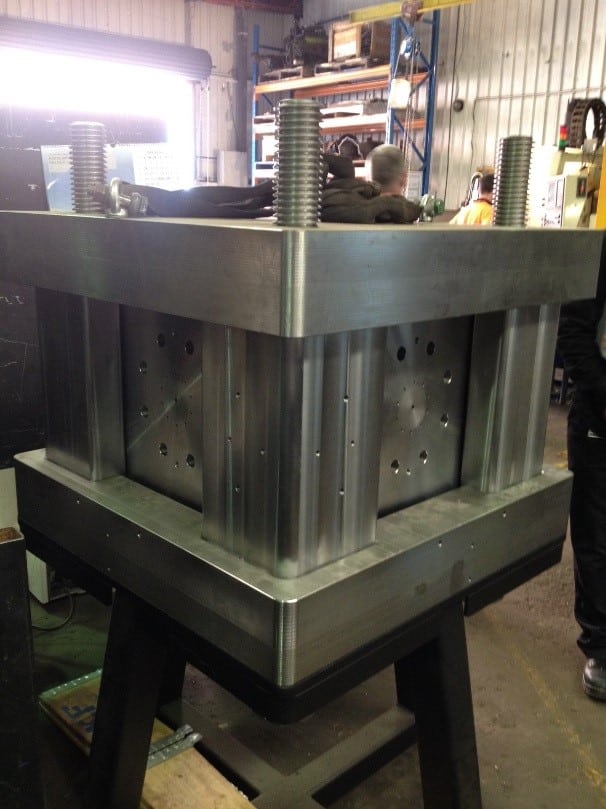Energy Geomechanics Group
The Energy Geomechanics Group (EGG) was established in 2007. The EGG is able to perform advanced research in many aspects of petroleum geo-mechanics to address issues associated with energy and mining exploration and production from conventional and unconventional resources through numerical and experimental studies. The geomechanics laboratory can perform experiments specific to client’s needs, and can perform short and long term consultancy services for resolving industry problems. The group has a number of postgraduate students working on different multidisciplinary geomechanics projects, with their focus on industry’s needs.
EGG has developed four state-of–the-art True Triaxial Stress Cells (TTSC), each having a separate application. The cells enable the simulation of different reservoir and drilling scenarios at different scales while applying anisotropic stresses. For example, EGG can run scaled hydraulic fracturing tests on different samples of rock cubes in the laboratory, and demonstrate what could happen with different fracture parameters under the same conditions in the field. This technology enhances the understanding of how to access or improve the production of oil and gas trapped deep beneath the Earth’s surface, especially in highly anisotropically stressed environments. Likewise it can perform rock mechanics tests required to solve mining issues. In cases of particular interest to the industry, EGG has been able to study a field’s wellbore conditions, and after fracturing a sample of rock from the production zone of the wellbore, make recommendations about mud weight to enable the operator to choose the optimised drilling rig resulting in substantial savings (in the $millions).
The projects cover a wide range of other fundamental research activities including reservoir geomechanics, CO2 sequestration and drilling. The group has strong capabilities in hydraulic fracturing, micro-seismic monitoring, sanding prediction, shale chemo-mechanical behaviour, 1D and 3D geomechanical modelling, and the effect of fracture surface morphology on hydro-mechanical behaviour of fractures.
Research Capabilities and Interests
The EGG has strong capabilities in conducting fundamental research, carrying out advanced lab experiments specific to client’s needs, and providing consultancy for resolving short and long terms industry problems. The EGG has strong local and international industry collaborations. Research activities undertaken by the group include:
- Hydraulic fracturing
- Shale chemo-mechanical stability.
- Extended applications of rock mechanics in various petroleum scenarios like CO2 sequestration and EOR.
- Well-bore stability analysis: log based approach as well as numerical methods, stress estimation techniques and developing empirical correlations between physical properties, petro-physical logs and image logs.
- 3D geo-mechanical analysis.
- Sanding prediction methods: analytical, numerical and experimental approaches
- Pore pressure estimation.
- Reservoir geo-mechanics: depletion effect on stresses and reservoir physical properties, the relationship between stresses and reservoir permeability, subsidence effects, and thermal effects
- Studying geometrical and mechanical properties of fractured surfaces.
Blue TTSC
Blue TTSC lab allows different drilling and reservoir scenarios to be simulated at a large scale while anisotropic stresses are applied. The apparatus can apply a set of independent forces of 315kN and 1000kN on horizontal and vertical direction, respectively, on the cube sample sizes of 30mm to 300mm. For the smallest sample, the stress can be as high as 350Mpa and 1110 Mpa in horizontal and vertical directions, correspondingly. A pore pressure of 21Mpa can also be applied during the test. A hole drilled in the centre of the sample allows fluid to be injected, simulating hydraulic fracturing. Sanding analysis can be performed by increasing the pore pressure and producing fluid and sand from the hole. Other potential applications include the ability to model formations with different geological properties by drilling through the sample both vertically and in a deviated manner during changes in orthogonal stress direction (deviatoric stresses). Fracture propagation and sanding initiation can be monitored using seismic transducers mounted around the sample on a set of specially made shims.
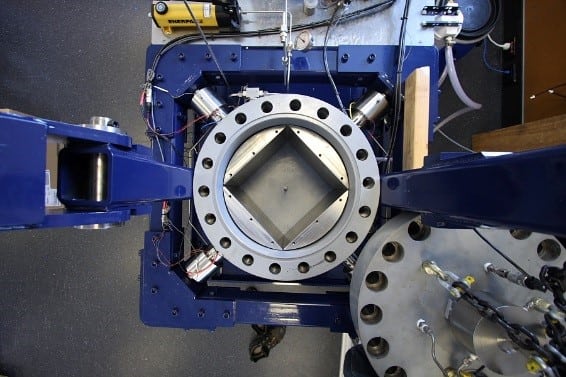
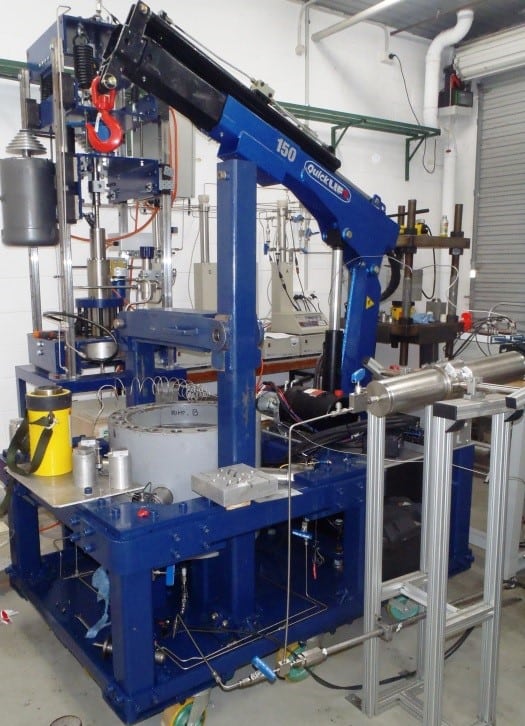
50mm NGL TTSC
A unique sleeve type True Triaxial Stress Cell (TTSC) simulates the true earth stresses to allow an anisotropic stress condition to be applied to a 50mm rock cube. The 50mm sample cube is the biggest sample that can retrieved through oil and gas conventional coring. The TTSC allows a vertical and two independent horizontal uniform stresses to be applied up to 70 Mpa in each direction on the sample. Additionally, pore pressure may be increased to 65 Mpa at 100 °C while 6 sets of LVDT strain gauges and 24 acoustic transducers monitor all deformations and micro seismic events within the rock. It is possible to inject and collect fluid from each six side of the cell using pore rod installed on each side of the sample. Using same pore rod system, fluid can be injected into the samples to simulate hydraulic fracturing, or to investigate fault re-activation during CO2 injection. Sanding analysis can also be performed by increasing pore pressure and producing pore fluid from the borehole. In-situ leaching, fracture propagation, sanding initiation, and production performance are monitored in real-time using the ultrasonic seismic transducers mounted around the sample.
The EGG is grateful to National Geosequestration Laboratory (NGL) of Australia for providing funding to build the stress cell. Funding for this facility was provided by the Australian Federal Government.
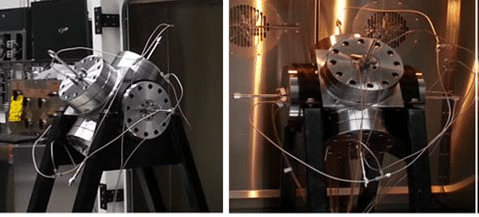

Swing NGL TTSC
A TTSC allows vertical and two independent horizontal forces of up to 1619 KN to be applied in each direction. The cell can house 150, 100, and 50 mm cubes of rock samples. Stress that can be applied to a 50mm cube sample is up to 645 Mpa. Additionally, temperature can be as high as 100 °C while 6 sets of LVDT strain gauges monitor the rock deformation. Micro seismic events within the rock can be measured using a 60 acoustic transducer. The TTSC can be used to for different types of rock experiments including hydraulic fracturing, in-situ recovery, sand production, among others.
The EGG is grateful to National Geosequestration Laboratory (NGL) of Australia for providing funding to build the stress cell. Funding for this facility was provided by the Australian Federal Government.
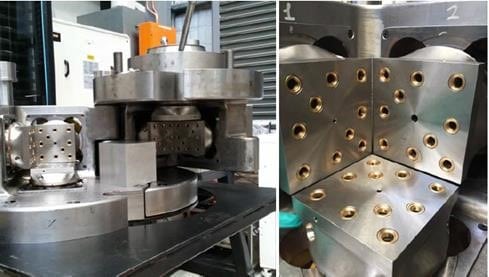
Pillar NGL TTSC
Pillar TTSC apparatus is under development and is very similar to Swing NGL TTSC. The main difference is in the sample size as it designed to accept the larger specimens (in the range of 150-300mm).
Specification summary:
- 6300 kN force in all direction (70Mpa on 300mm cube, 158 Mpa on 200mm, and 280 Mpa on 150 mm cube).
- 60-Channel Acoustic Transducer
- 6 Strain reading
- Temperature – 100C°
- 150-300mm cubical samples
The PGG is grateful to National Geosequestration Laboratory (NGL) of Australia for providing funding to build the stress cell. Funding for this facility was provided by the Australian Federal Government.
